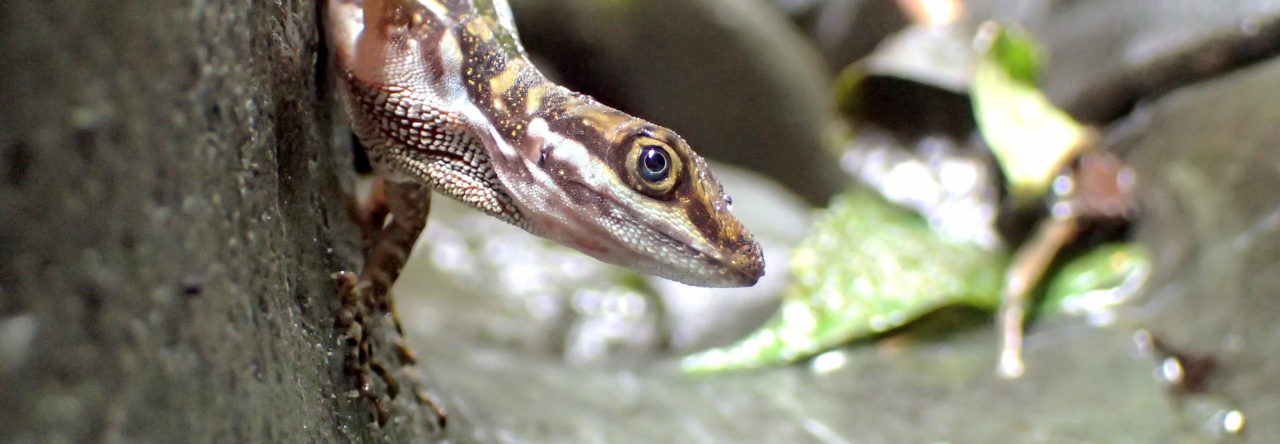 Though temperature-dependent sex determination is one of the most interesting things about reptiles, this mode of sex determination unfortunately does not extend to anoles. In iguanid lizards, sex determination has long be known to be a consequence of sex chromosomes, males being the heterogametic (XY) sex.
Though temperature-dependent sex determination is one of the most interesting things about reptiles, this mode of sex determination unfortunately does not extend to anoles. In iguanid lizards, sex determination has long be known to be a consequence of sex chromosomes, males being the heterogametic (XY) sex.
Reptilian sex chromosomes occupy a strange middle ground within vertebrates: on one hand, amphibian and fish sex chromosomes are marked by rapid turnover in precisely which chromosomes determine sex ; on the other hand, bird and mammal sex chromosomes are characterized by their stability over millions of years. In an early-view paper in Evolution, Rovatsos et al. (2014) show that sex chromosomes are stable in at least some reptiles–in anoles, they have been conserved since before the diversification of the genus.
The authors began by picking five X-linked and three autosomal genes from the recently published Anolis carolinensis genome, and use quantitative PCR to confirm that the X-linked but not the autosomal genes have double the gene dosage values in female vs. male A. carolinensis. Next, they extend their sequencing efforts to seventeen other species from across Anolis as well as three species of phrynosomatid lizards. Remarkably, similar patterns of gene dosage differences between males and females are seen across the sampled taxa, suggesting that the same genes are X-linked in all these species. This result implies the stability of the X-chromosome for at least 70 million years, pre-dating the divergence of Dactyloidae and Phrynosomatidae.
This finding puts a dent in a long standing hypothesis for why birds and mammals have stable sex chromosomes–their stability was attributed to “the lower susceptibility of homoiotermic endothermic vertebrates (mammals and birds) to thermally-induced sex reversals due to their effective thermoregulation.” Rovatsos et al. (2014) call for new explanations for “why some vertebrate lineages possess frequent turnovers of poorly differentiated sex chromosomes, while others show a long-term stability of sex chromosomes connected with their progressive differentiation,” explanations that must take into account the stability of sex chromosomes across anoles and potentially across all iguanian lizards.




 Small in size, but a global giant in biodiversity, Ecuador is awash in all manner of fauna and flora. Birds, butterflies, trees—the country is a hotspot for just about everything. But no group of organisms is more beautiful, more charismatic, more scientifically captivating than Ecuador’s reptiles and amphibians. The Amazon rainforest dominates the attention of the public, but other parts of the country, especially the mountainous regions, are just as biologically rich. One such area is the small parish of Mindo in Pichincha Province, home to 102 species of creepy crawlies. And what an ensemble! Brilliant colors, toxic skin and venom, sweet serenades, menacing looks, gorgeous displays—this region is an encyclopedia of herpetology in just 268 square kilometers.
Small in size, but a global giant in biodiversity, Ecuador is awash in all manner of fauna and flora. Birds, butterflies, trees—the country is a hotspot for just about everything. But no group of organisms is more beautiful, more charismatic, more scientifically captivating than Ecuador’s reptiles and amphibians. The Amazon rainforest dominates the attention of the public, but other parts of the country, especially the mountainous regions, are just as biologically rich. One such area is the small parish of Mindo in Pichincha Province, home to 102 species of creepy crawlies. And what an ensemble! Brilliant colors, toxic skin and venom, sweet serenades, menacing looks, gorgeous displays—this region is an encyclopedia of herpetology in just 268 square kilometers.







